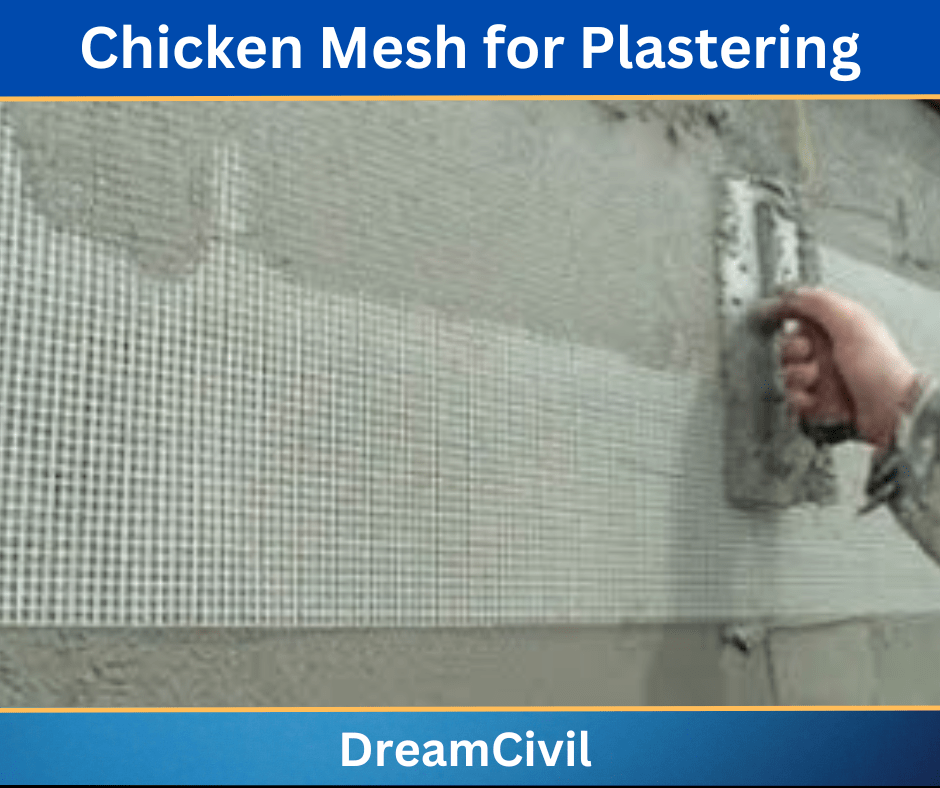Table of Contents
Chicken mesh may be defined as a net like material made by twisting two adjacent wires minimum four times, making a strong and long lasting honeycomb like mesh structure.
A chicken mesh for plastering owns some special characteristics, due to which it is employed vastly in plaster works.
Chicken mesh improves the strength and durability of the plaster coat laid. It is also employed to control the appearance of ruptures in the wall.
Cracks evolved due to numerous causes, such as effect of seasonal changes, shrinkage cracks, poor construction practices, etc.
Chicken mesh is fed to control the expansion of gaps in plaster because of the above reasons.
1. Necessity of Chicken Mesh for Plastering
To control a crack in plastering work we employ chicken mesh at the intersection.
Various materials such as between column and wall junctions where the coefficient of thermal expansion.
Different material possesses various properties, and because of that, the chances of cracking after plastering is bound to occur, that’s why we use chicken mesh.
Chicken mesh has a similar role as reinforcement accomplishes in concrete.
It reinforces the plaster against various forces.
Mostly to bypass the crack that originated due to inadequate gap filling between the RCC column & Brick wall joint.
Therefore we employed chicken mesh in plastering, and also due to this, there will be a useful bond appearance between the finishing surfaces of the RCC column & Brick wall.
Chicken mesh in old plaster is employed to control cracking and maintain the plaster together. The mesh also allows counter cracks induced by the twisting of plaster laths.
Nowadays, workers employ galvanized wire mesh screwed to old wooden laths to cover repairs against cracking.
In exterior plastering, you shouldn’t employ chicken mesh if the plastering is slimmer than 20 mm since the mesh is not galvanized adequately and offers you a chance for rust expansion, and then the plastering will collapse before it’s due.
2. Types Of Chicken Mesh
The various types of chicken mesh used for plastering are as follows:-
a. Wired mesh
b. Fiberglass mesh
c. Plastic mesh
a. Wire Mesh
Wire-type mesh is also categorized into three types of mesh.
They are as follows:
i. Light-expanded metal mesh
ii. Welded wire mesh
iii. Linked chain mesh
i. Light Expanded Metal Mesh
Light expanded metal mesh is a mesh prepared out of sheet metal, cut, and pushed to make a diamond-shaped design on the sheet of metal.
It is broadly employed to reinforce plaster or stucco. It is furthermore employed as a reinforcement material for interior decoration. The light-expanded metal mesh is prepared by stretching a metal sheet.
So, it does not include any welds and bends on it. This mesh has properties like durability, strength, and lightweight, respectively. Also, the ribbed structure delivers maximum adhesion to the surface.

ii. Welded Wire Mesh
It is made up of thin low – carbon-drawn wire or galvanized wire of diameter varying between 0.4 mm to 1.5 mm. The wires are encountered in perpendicular directions and are linked by spot welding.
Welded wire mesh is appropriate for plastering both on uneven and rough surfaces. Welded wire mesh is employed for interior as well as exterior plaster works. It causes the plaster smooth and strong. It also enables to bypass of the formation of cracks in plaster.

iii. Linked Chain Mesh
Linked chain mesh is also known as mini or micro chain wire fences. It is normally employed in plaster for the prevention of crack appearance on the wall due to temperature modifications.
The linked chain mesh is caused up of materials like low-carbon steel and galvanized wire. It is a lightweight material.
The thickness of wires used for making linked chain mesh is 0.5 mm to 2 mm. The linked chain mesh is used for applications like architectural interior wall plaster and outdoor wall insulation plaster.
Before using the plaster coat, the linked chain mesh is fixed to the surface where the plaster is to be accomplished. After that, the plaster is spread instantly.
Linked chain mesh is also employed where the structure is prone to high-vibration results due to different types of machines.

b. Fibreglass Mesh
Fiberglass mesh is a type of chicken mesh that includes some unique features like it does not burn and it also maintains high strength. This mesh is a cheap and lightweight material.
Due to the unique character of fiberglass mesh, it has a broad variety of applications, such as being employed in the construction of plaster facades and employed on internal walls and ceiling surfaces as well. Fiberglass mesh is unsusceptible to alkalis; hence it does not decay and will not rust over time.
It is highly unsusceptible to stretching and tearing and also covers the surface from a crack appearance. The application of fiberglass mesh is moderately easy.

c. Plastic Mesh
Plastic mesh is a choice over the traditional metal mesh. It is appropriate for both, interior as well as exterior surfaces. Like every other type of chicken mesh, the plastic mesh also delivers opposition against the crack appearance.
Besides this, it also improves the mechanical strength of the structure or the wall and controls deformation as well. Plastic mesh does not restrict its usefulness to plastering; rather, it has a broader scope.
It is employed for plasterwork and paintwork by pouring floors, making sound and heat-insulated walls, protecting the facades, and as a reinforcement for the door frame and windows frame.
The form of the opening of the plastic mesh is either square or rectangular. It is also employed for a more extended span of walls.

This was for the chicken mesh for plastering.
3. References1. Content Filter & Authenticity Checking Team, Dream Civil International (Our team checks every content & detail to maintain quality.) |
Read Also: Clay Roof Tiles

